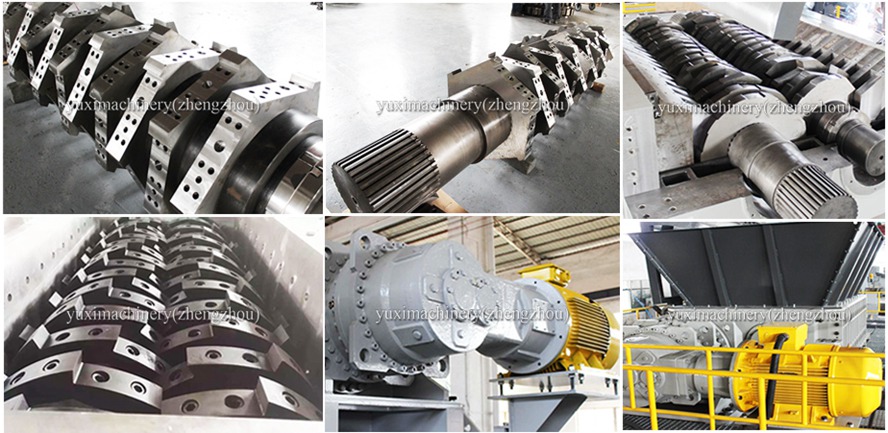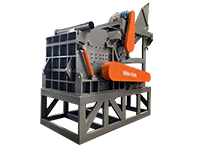In the field of industrial solid waste treatment and resource recycling, the double shaft shredder has become a key equipment to achieve the goals of "reduction and resource utilization" due to its unique structural design and strong material crushing capacity. This article will conduct a professional and in-depth analysis of it from the dimensions of technical parameters, working principle, core advantages, application scenarios and selection points.
1. Technical Parameters: Precise Control from Feed to Production Capacity
The performance of a double shaft shredder is defined by a series of key parameters, which directly determine the adaptability and processing efficiency of the equipment to materials:
• Feed Size: Conventional models cover 4-102 inches, and customized designs are supported to match materials of different volumes (such as large tires, industrial waste metal blocks, etc.).
• Production Capacity: The processing capacity varies greatly, from 880 lbs/hour to 132,277 lbs/hour, which can meet the diverse needs of small recycling stations and large industrial treatment plants.
• Drive and Torque: The "motor + reducer" drive scheme is adopted to achieve low speed and high torque output, ensuring effective shredding of high-toughness and high-viscosity materials (such as rubber and plastic films).
• Cutting Tools and Shaft System: The cutter shaft is equipped with special alloy steel cutting tools (high-speed steel or tool steel processed by special technology), which have wear resistance, high strength and repairability; the shaft system is designed as a dual-shaft independent drive, through helical tool arrangement and hexagonal tool inner hole/spindle surface, uniform force and efficient cutting are realized.
2. Working Principle: The Shredding Philosophy of Dual-Shaft Linkage
The core logic of the double shaft shredder lies in the synergistic effect of "extrusion-shearing-shredding":
The equipment adopts a double-shaft structure, and the two shafts are driven independently and rotate in opposite directions. After the material enters the crushing chamber, it is first extruded by the two shafts to realize automatic feeding; then, under the shearing engagement of the rotating tools, it is gradually shredded into particles that meet the requirements.
The advantage of this design is that when the cutter shaft and cutting tools operate at low speed and high torque, the phenomenon of "shaft winding" or "jamming" common in traditional crushing equipment can be avoided, thereby ensuring production efficiency and equipment stability. At the same time, the split box structure makes the disassembly and maintenance of the cutter shaft (including shaft, blade, bearing, sealing system) more convenient, reducing operation and maintenance costs.

3. Core Advantages: Technical Barriers of Industrial-Grade Shredding
The competitiveness of the double shaft shredder comes from multi-dimensional technical optimization, and these advantages make it stand out in the field of solid waste treatment:
1. Intelligent Control: Equipped with a PLC control system, it has start, stop, reverse and overload automatic reverse functions, realizing full-process automatic control and reducing labor intervention costs.
2. Sealing and Durability: The bearing adopts six-layer sealing technology, which is effective in waterproofing and dustproofing, greatly extending the service life of the bearing and adapting to complex and harsh industrial environments (such as corrosive environments in medical waste treatment scenarios).
3. Customized Adaptation: Different types of cutting tools and shaft configurations can be selected according to the material (such as metal, plastic, wood) and shape (such as film, block, fiber) of the shredded material to ensure the pertinence of the shredding effect.
4. International Certification and Quality: Mainstream brand equipment has passed the EU CE certification, and core components (such as motors) use internationally renowned brands to ensure the reliability and compliance of the equipment from the source.
4. Application Scenarios: Resource Recycling Solutions Covering All Industries
The double shaft shredder has extremely strong material adaptability and can be widely used in the following fields:
• Industrial Solid Waste and Hazardous Waste: Crush industrial waste and solid hazardous waste to lay the foundation for subsequent harmless treatment or resource utilization.
• Metal Recycling: Process waste steel, waste aluminum, waste copper and other metal materials, and the shredded materials are convenient for sorting, smelting and reuse.
• Plastic and Rubber: Crush plastic bottles, plastic bags, tires, rubber products, etc. to support recycling or energy utilization.
• Electronic and Medical Waste: Specially treat electronic waste (such as waste household appliances, circuit boards) and medical waste (such as waste needles, medicine bottles) to realize volume reduction and environmental protection disposal.
• Wood and Papermaking: Crush wood scraps, waste paper, and pulp blocks to help the recycling of biomass energy or papermaking raw materials.

5. Selection and Procurement Points
When selecting a double shaft shredder, enterprises should focus on the following dimensions:
• Material Characteristics: Clarify the material, hardness, humidity and size of the material to be shredded, so as to match the feed size, tool type and equipment power.
• Processing Scale: According to the hourly processing capacity requirement, select the equipment model corresponding to the production capacity range (such as YX600, YX1000, YX2200 series).
• Supporting Requirements: Consider whether it is necessary to integrate a waste recycling line (such as conveying and sorting equipment) or optional equipment (such as magnetic separation and air separation devices) to realize the integrated process of shredding and recycling.
• Manufacturer Strength: Give priority to manufacturers with independent research and development capabilities, perfect after-sales service (such as spare parts supply, technical support) and mature cases to ensure the maximum value of the equipment throughout its life cycle.
6. Professional Q&A Session
1. What is the core difference between a double shaft shredder and a single shaft shredder?
Answer: The double shaft shredder adopts the method of double-shaft independent drive and tool meshing shear, which has stronger adaptability to high-toughness materials and is not easy to wrap the shaft; the single shaft shredder relies on the cooperation of single-shaft rotation and fixed tools, which is more suitable for brittle and easy-to-break materials. The processing efficiency and material adaptability are weaker than those of the double shaft model.
2. How to maintain the cutting tool after wear?
Answer: The service life can be extended through tool repair processes (such as surfacing wear-resistant layers); when the wear reaches a certain level, the cutter head or the entire set of tools can be replaced. The split box design of the equipment makes the tool replacement operation convenient and efficient.
3. Is the energy consumption of the double shaft shredder on the high side?
Answer: It adopts low-speed and high-torque drive, and the energy consumption per unit material processing is not high; and through PLC intelligent control, no-load shutdown and overload protection can be realized, further optimizing energy consumption performance and meeting energy saving and environmental protection requirements.

The double shaft shredder, as a key equipment for resource circulation and solid waste governance, its technical depth and application breadth are continuously expanding with industrial development. Choosing suitable equipment and conducting scientific operation and maintenance will inject strong momentum into the green production and sustainable development of enterprises.
 Shredding Machine
Shredding Machine
 Waste Recycling Line
Waste Recycling Line
 Optional Equipment
Optional Equipment



